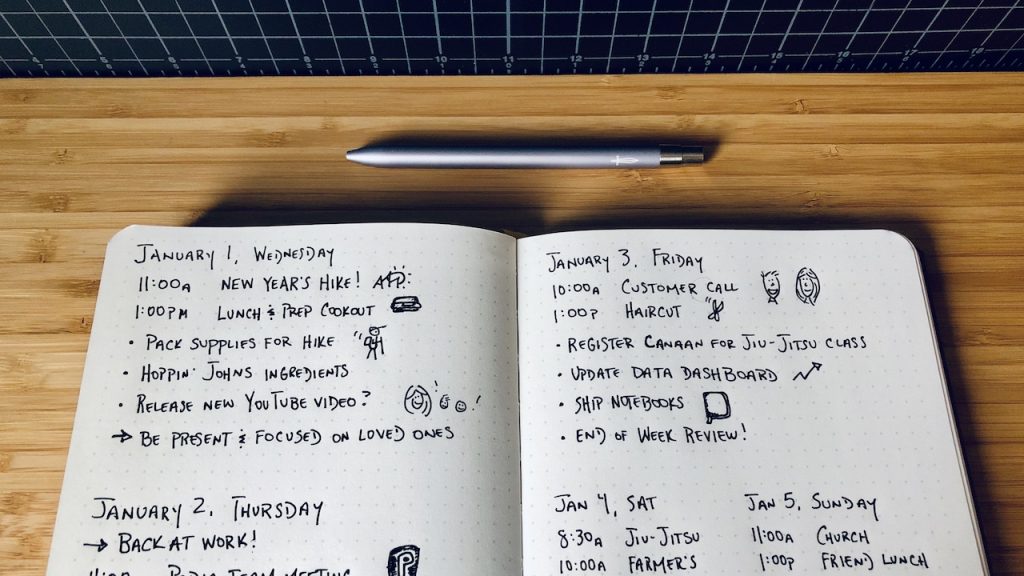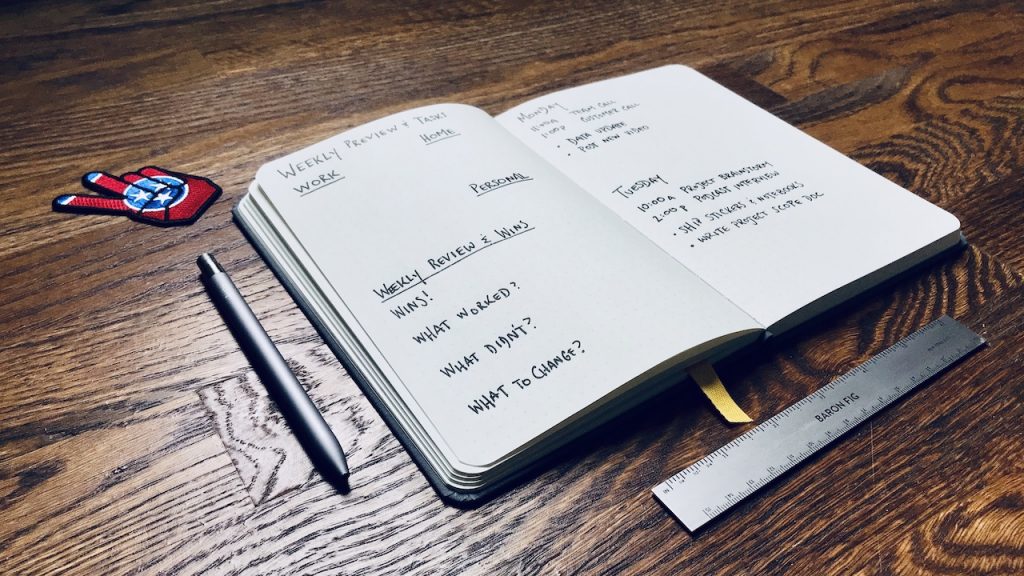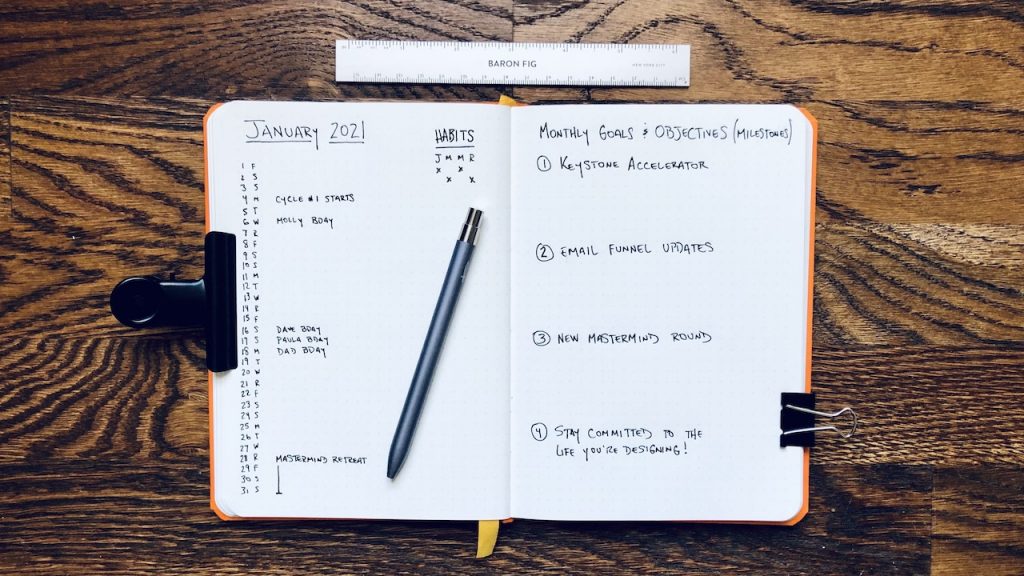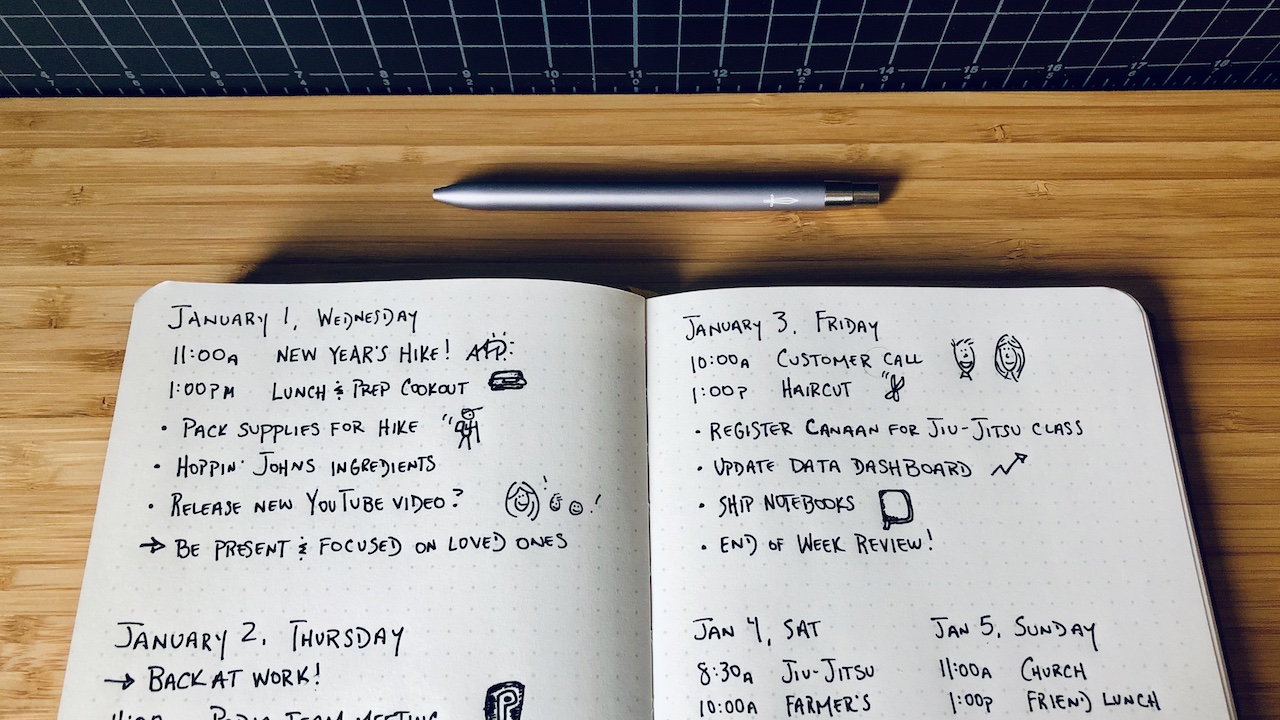We are getting very close to the end of 2020 and transitioning into 2021. There’s a lot of good energy around moving into a new year at any time – but this year feels particularly special.
What I’m going to share with you in this post are my top five tips for setting up your very first bullet journal. These are great tips for setting up your very first bullet journal as a beginner.
To start – there are a lot of misconceptions about the bullet journal!
If you watch YouTube videos, scroll through Instagram, or Google “Bullet Journal” – you’ll see a lot of fancy layouts. Like it takes a lot of time of your week, of your day, of your month, of your life to use one.
I’m here to tell you that none of that is true.
The bullet journal is as minimalist or as extravagant as you want it to be. I myself tend to be very minimalist with my bullet journal. The fanciest I get are some simple icons, or stick figures, st doodling in my bullet journal.
It’s not some of the beautiful, artistic bullet journal layouts and setups that you’re going to see. Come one, come all, my beginner bullet journal friends, and let me give you my top five tips for setting up your first bullet journal. Let’s go!
1. Start with the daily log
You may think that this is too simple. That’s good news. It should be too simple at the beginning. Because when you are practicing consistently you will build confidence. The best way to do that is to start with the simple daily log in your bullet journal.
Well, what do I mean by that? All you’re going to do is write down the day of the week, the day of the month. What I like to do is start listing first the appointments, or meetings, or any kind of specific time of day agenda items. I write all those down, and then right below them, I start to make my bullet points of the different tasks that I have for that day. That’s all you have to do to begin with a bullet journal.

Now, as you go through and you complete tasks for the day, you’re going to X out that bullet. If there’s something that you need to do tomorrow, draw an arrow or a right angle bracket to show the task needs to be done tomorrow. If it’s something that you just realize, “Hey, I actually don’t need to do this,” then strike through it completely and be done with it.
So that is the very first tip for starting your first bullet journal. start with the daily log. And I would do that for up to seven to 10 days. Two weeks of consistently putting down the day of the week, the day of the month, any agenda items, and tasks that you have for the day.
You can also draw a short little dash in your key for the day to indicate that you’re making a note about something. Maybe it’s a task. Maybe it’s something that you heard or realized, or thought of during the day. In that sense you can also use the bullet journal as daily journal too.
2. Move into a weekly spread or a master task list.
One of the challenges that a lot of bullet journal beginners have is writing too many tasks down on Monday. Then a bunch get migrated to Tuesday… then you still don’t get through all of them on Tuesday… and now you’re writing down tasks three times. I understand this is tough for a productive, efficiency-focused brain. You’re like, “I’m going to write down the same thing multiple times?”
So what I would do with that is create a master task list for your week. Focus on the top three tasks and migrate them into whatever day you’re currently on.
Those are going to become your top three tasks for the day. If you complete everything, double thumbs up for you! Now go back to your master task list and grab an extra task. Move those into your daily task log or your daily log in the bullet journal.

A master task list is going to be valuable for you. As you build consistency with the daily log, start to plan out your week ahead with a master task list. Look at the week ahead and say, “These are the two to three main goals or objectives that I have for the week.” Then focusing on whatever sub-tasks that you have related to those goals.
Start to look at your week from a broader perspective than the daily log. Think about, “What are the main outcomes and objectives that I have for this week?” Create a master task list and then start to assign those tasks out by the day. Assign them based on when they need to be done, or when they fit into your top tasks for that specific day.
3. Expand your practice to monthly layouts
I keep a very simple minimalist monthly layout. A column of the days of the month with the corresponding first letter of the days of the week right next to it. This way I can see different events or major milestones that I have in my business, in my life, in my work, with my family.
I’ll write down events for birthdays, launches, or new videos. I keep it simple and minimal so that I can focus on the daily and weekly productivity spreads.

I spend 80% to 90% of my bullet journaling practice on weekly and daily. The monthly does help me zoom out past daily, past weekly, to the month. I take elements from the weekly layout and think about each one from a broader perspective.
“What do I want to be doing this month? What are my main milestones for the month? What goals and objectives do I have? And what are the deliverables? What are the sub-tasks that need to get done in order for me to achieve these goals I have for the month ahead?”
If you’re watching this and thinking – “Matt, you’re talking about big picture goal setting. I thought this was about a bullet journal setup.”
The bullet journal is my lever for making sure that I’m getting the most important work done every day. If you want to see how I break down my goals and set the plan to achieve them in a day, week, month, or year – watch my video below!
4. Use a Simple Habit Tracker.
I love to use the bullet journal as a tracker. It’s a lot of fun and gives you a nice endorphin boost. You feel awesome going through a tracker and checking off things that matter to you. This is an exciting feeling to have, and it’s one of the most popular things to do with bullet journals. It could be like a spending tracker, or a savings tracker, or a debt payoff tracker. You can use any of those methods as a tracker in your bullet journal.
If you want to go deeper on trackers – I have an entire video about habit trackers in the bullet journal. But what I want you to focus on as a beginner is one habit or one thing that you want to track in the new year. It’s a perfect way to build confidence in yourself and in your practice. If this is your first bullet journal, track it as a habit!
The easiest way to start is to use the monthly layout as a simple habit tracker. All I do is I write down the first letter of my habit next to the corresponding days of the month. At the same time that I’m looking at my my monthly layout, I can make little Xs below that specific habit.
The three that I focus on are daily journaling, reading, and then exercising 3-4 days per week. I’m trying to shoot for like 60% to 70% completion for the month, and so that’s doing each of those 20 to 25 times.
A challenge for putting habits on the same page as the monthly layout is it limits the number you want to track. I’m not a big multi-habit tracker myself. I like to focus on the two or three to four core ones.
But if I was tracking several I would dedicate an entire page and create a simple table. Then I could follow the tracker for movement, journaling, reading, taking notes, meditating. For example – January 1, I was able to move. I wrote in my journal. I read. I didn’t take any notes, but I was able to meditate.
There are tons of ways to make beautiful, elaborate habit trackers. If you want to spend some time doing that, I’d say more power to you. They look awesome and for a lot of people, it’s kind of a way to meditate and kind of slow down. That is amazing as well.
For those of you thinking that I’m against artistic, lovely bullet journals – I’m 100% for them. I want to help you as a beginner! Don’t think that your bullet journal has to be beautiful in order for it to be functional and useful! I don’t want it to be an extra source of overwhelm for you. I want this to be something that helps free you and focus on the things that matter to you.
5. Consistency Creates Confidence
The best way to be consistent early on is to start small. Start with the daily. Once you get comfortable and consistent with the daily, you’re confident. You’re like, “Yeah, I can kind of do this. I thought I wasn’t going to be able to do it. Look at me doing it.”
Then you expand out a little bit because you’ve grown. You’ve developed, you’re more confident, and you can start to say to yourself, “Okay, let’s look at the week ahead.” Once you do that for a couple of weeks, you’re like, “All right. I’m expanding again. I’m gaining more confidence. Let’s look at the month ahead.”
If you’re starting this January 1 or 4, (which is the first Monday of 2021) – for the first two weeks only focus on your daily log. Then on January 18th spend the next two weeks doing a weekly layout. Think about those master tasks. What are your goals and objectives for the week? Do that for the next two weeks.
Then on February 1 (which is also, wonderfully, a Monday) start to expand and look at the month ahead. “What do I want to do in the month ahead with my goals, with my objectives? What kind of projects do I want to work on? What are some things that I can knock out in the pursuit of larger annual goals I have, or quarterly goals?” If you want to watch my video all about goal setting and achievement, watch the video or listen to the podcast for more!
Think about how you’re going to expand. How you can start small, and go from daily, to weekly, to monthly. Then you can start to do quarterly or annual, but you’re building up to it!
I see with bullet journal beginners is spending time on your index, future log, then it’s “Okay, now I have to do the month.” Once you do the month, “All right, what do I do for the weekly?”
Before you even get to day one you’re thinking, “I’ve already done hours of work at this point. If I don’t fill in each day I’m wasting space. I feel like I’m not actually very good at this.”
Too often at this point – a lot of people stop bullet journaling. This happens with any kind of habit, but I’m going to have another post about that later.
That’s why I turn things around a little bit, and think, “What is the simplest start that we can make?” Going day by day. Taking it day by day, my friends.
That’s what I want you to focus on as a bullet journal beginner. Go from daily, to weekly, to monthly. Have a habit or something else that you want to track on a daily or multi-day basis.
Remember that consistency creates confidence
Those are my five bullet journal tips for beginners. I hope that you start a bullet journal in 2021! It has been a life-changing habit and practice for me. It’s amazing.
You can find links to all the bullet journal supplies that you would ever want to – well, maybe not all the supplies…. I don’t link to washi tape and binder clips, because that’s not something that I use, but you can find those on Amazon.
Thank you so much for reading and clicking on any of the other content links in the post. Subscribe to my email list for early access to content! I also host special training for productivity and planning strategies. Have a great day!

Leave a Reply